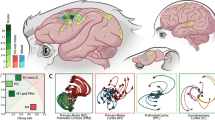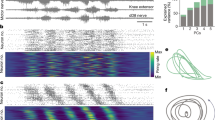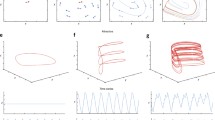Abstract
As a dynamical model for motor cortical activity during hand movement we consider an artificial neural network that consists of extensively interconnected neuron-like units and performs the neuronal population vector operations. Local geometrical parameters of a desired curve are introduced into the network as an external input. The output of the model is a time-dependent direction and length of the neuronal population vector which is calculated as a sum of the activity of directionally tuned neurons in the ensemble. The main feature of the model is that dynamical behavior of the neuronal population vector is the result of connections between directionally tuned neurons rather than being imposed externally. The dynamics is governed by a system of coupled nonlinear differential equations. Connections between neurons are assigned in the simplest and most common way so as to fulfill basic requirements stemming from experimental findings concerning the directional tuning of individual neurons and the stabilization of the neuronal population vector, as well as from previous theoretical studies. The dynamical behavior of the model reveals a close similarity with the experimentally observed dynamics of the neuronal population vector. Specifically, in the framework of the model it is possible to describe a geometrical curve in terms of the time series of the population vector. A correlation between the dynamical behavior of the direction and the length of the population vector entails a dependence of the “neural velocity” on the curvature of the tracing trajectory that corresponds well to the experimentally measured covariation between tangential velocity and curvature in drawing tasks.
Similar content being viewed by others
References
Amari S (1972) Characteristics of random nets of analog neuron-like elements. IEEE Trans Syst Man Cybern 2:643–657
Amirikian BR, Lukashin AV (1992) A neural network learns trajectory of motion from the least action principle. Biol Cybern 66:261–264
Atiya A, Baldi P (1989) Oscillations and synchronization in neural networks: an exploration of the labelling hypothesis. Int J Neural Syst 1:103–124
Berthier NB, Singh SP, Barto AG, Houk JC (1991) Distributed representation of limb motor programs in arrays adjustable pattern generators. Technical Reports from the Center for Neuroscience Research on Neuronal Populations and Behavior, Northwestern University Medical School, Chicago, IL 60611, USA
Bullock D, Grossberg S (1988) Neural dynamics of planned arm movements: emergent invariants and speed-accuracy properties during trajectory formation. Psycol Rev 95:49–90
Burnod Y, Grandguillaume P, Otto I, Ferraina S, Johnson PB, Caminiti R (1992) Visuomotor transformations underlying arm movement toward visual targets: a neural network model of cerebral cortical operations. J Neurosci 12:1435–1453
Corradini ML, Gentilucci M, Leo T, Rizzolatti G (1992) Motor control of voluntary arm movements. Kinematic and modelling study. Biol Cybern 67:347–360
Dehaene S, Changeux JP, Nadal JP (1987) Neural networks that learn temporal sequences by selection. Proc. Natl Acad Sci USA 84:2727–2731
Georgopoulos AP (1990) Neural coding of the direction of reaching and a comparison with saccadic eye movements. Cold Spring Harbor Symp Quant Biol 55:849–859
Georgopoulos AP, Kalaska JF, Caminiti R, Massey JT (1982) On the relations between the direction of two-dimensional arm movements and cell discharge in primate motor cortex. J Neurosci 2:1527–1537
Georgopoulos AP, Caminiti R, Kalaska JF, Massey JT (1983) Spatial coding of movement: a hypothesis concerning the coding of movement direction by motor cortical populations. Exp Brain Res [Suppl] 7:327–336
Georgopoulos AP, Schwartz AB, Kettner RE (1986) Neuronal population coding of movement direction. Science 233:1416–1419
Georgopoulos AP, Kettner RE, Schwartz AB (1988) Primate motor cortex and free arm movement to visual targets in three-dimensional space. II. Coding of the direction of movement by a neuronal population. J Neurosci 8:2928–2937
Georgopoulos AP, Lurito JT, Petrides M, Schwartz AB, Massey JT (1989) Mental rotation of the neuronal population vector. Science 243:234–236
Georgopoulos AP, Taira M, Lukashin AV (1993) Cognitive neurophysiology of the motor cortex. Science 260:47–52
Grossberg S, Cohen M (1983) Absolute stability of global pattern formation and parallel memory storage by competitive neural networks. IEEE Trans Syst Man Cybern 13:815–826
Guyon I, Personnaz L, Nadal JP, Dreyfus G (1988) Storage and retrieval of complex sequences in neural networks. Phys Rev A 38:6365–6372
Hopfield JJ (1984) Neurons with graded response have collective computational properties like those of two state neurons. Proc Natl Acad Sci USA 81:3088–3092
Hopfield JJ, Tank DW (1986) Computing with neural circuits: a model. Science 233:625–633
Jordan MI (1986) Attractor dynamics and parallelism in a connectionist sequential machine. In: Proceedings of the 8th Annual Conference of the Cognitive Science Society. Erlbaum, Hillsdale, NJ, pp 531–546
Kleinfeld D (1986) Sequential state generation by model neural networks. Proc Natl Acad Sci USA 83:9469–9473
Kleinfeld D, Sompolinsky H (1988) Associative neural network model for the generation of temporal patterns. Biophys J 54:1039–1051
Lacquaniti F, Terzuolo C, Viviani P (1983) The law relating kinematic and figurai aspects of drawing movements. Acta Psychol 54:115–130
Lukashin AV (1990) A learned neural network that simulates properties of the neuronal population vector. Biol Cybern 63:377–382
Lurito JT, Georgakopoulos T, Georgopoulos AP (1991) Cognitive spatial-motor process. 7. The making of movement at an angle from a stimulus direction: studies of motor cortical activity at the single cell and population levels. Exp Brain Res 87:562–580
Martin KAC (1988) From single cells to simple circuits in the cerebral cortex. Q J Exp Physiol 73:637–702
Massey JT, Lurito JT, Pellizzer G, Georgopoulos AP (1992) Three-dimensional drawing in isomeric conditions: relation between geometry and kinematics. Exp Brain Res 88:685–690
Massone L, Bizzi E (1989) A neural network model for limb trajectory formation. Biol Cybern 61:417–425
Pearlmutter BA (1989) Learning state space trajectories in recurrent neural networks. Neural Computations 1:263–269
Schoner G, Kelso JAS (1988) Dynamic pattern generation in behavioral and neural systems. Science 239:1513–1520
Schwartz AB (1992) Motor cortical activity during drawing movements: single-unit activity during sinusoid tracing. J Neurophysiol 68:528–541
Schwartz AB (1993) Motor cortical activity during drawing movements: population representation during sinusoid tracing. J Neurophysiol (in press)
Schwartz AB, Anderson BJ (1989) Motor cortical images of sinusoidal trajectories. Soc Neurosci Abstr 15:788
Schwartz AB, Kettner RE, Georgopoulos AP (1988) Primate motor cortex and free arm movements to visual targets in three-dimensional space. I. Relations between single cell discharge and direction of movement. J Neurosci 8:2913–2927
Sejnowski TJ (1976) On the stochastic dynamics of neuronal interaction. Biol Cybern 22:203–211
Soechting JF, Terzuolo CA (1986) An algorithm for the generation of curvilinear wrist motion in arbitrary plane in three-dimensional space. Neuroscience 19:1393–1405
Sompolinsky H, Kanter I (1986) Temporal association in asymmetric neural networks. Phys Rev Lett 57:2861–2864
Viviani P, Terzuolo C (1982) Trajectory determines movement dynamics. Neuroscience 7:431–437
Williams RJ, Zipser D (1989) A learning algorithm for continually running fully recurrent neural networks. Neural Computations 1:270–280
Author information
Authors and Affiliations
Additional information
On leave of absencefrom the Institute of Molecular Genetics, Russian Academy of Sciences, Moscow, Russia.
Rights and permissions
About this article
Cite this article
Lukashin, A.V., Georgopoulos, A.P. A dynamical neural network model for motor cortical activity during movement: population coding of movement trajectories. Biol. Cybern. 69, 517–524 (1993). https://doi.org/10.1007/BF01185423
Received:
Accepted:
Issue Date:
DOI: https://doi.org/10.1007/BF01185423




